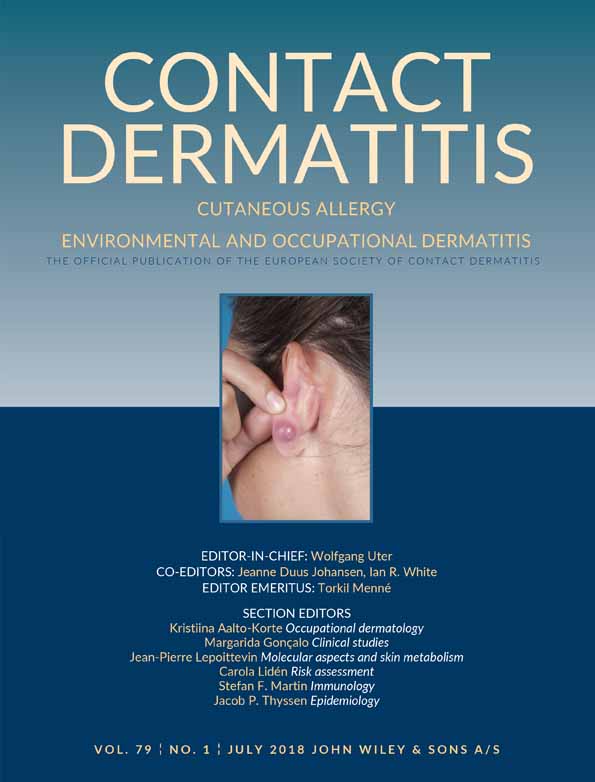Occupational contact dermatitis caused by polyurethane foam: 6 cases
Corresponding Author
Florence Castelain
Department of Dermatology, University Hospital of Besançon, Besancon, France
Correspondence
Dr Florence Castelain, Department of Dermatology, University Hospital of Besançon, 3 Boulevard Alexandre Fleming, 25000 Besançon Cedex, France.
Email: [email protected]
Search for more papers by this authorPascal Girardin
Department of Dermatology, University Hospital of Besançon, Besancon, France
Search for more papers by this authorEmmanuelle Penven
Occupational Diseases Department, University Hospital of Nancy, Nancy, France
Search for more papers by this authorFabien Pelletier
Department of Dermatology, University Hospital of Besançon, Besancon, France
Search for more papers by this authorCorresponding Author
Florence Castelain
Department of Dermatology, University Hospital of Besançon, Besancon, France
Correspondence
Dr Florence Castelain, Department of Dermatology, University Hospital of Besançon, 3 Boulevard Alexandre Fleming, 25000 Besançon Cedex, France.
Email: [email protected]
Search for more papers by this authorPascal Girardin
Department of Dermatology, University Hospital of Besançon, Besancon, France
Search for more papers by this authorEmmanuelle Penven
Occupational Diseases Department, University Hospital of Nancy, Nancy, France
Search for more papers by this authorFabien Pelletier
Department of Dermatology, University Hospital of Besançon, Besancon, France
Search for more papers by this author
REFERENCES
- 1Goossens A, Detienne T, Bruze M. Occupational allergic contact dermatitis caused by isocyanates. Contact Dermatitis. 2002; 47: 304-308.
- 2Engfeldt M, Goossens A, Isaksson M, Zimerson E, Bruze M. The outcome of 9 years of consecutive patch testing with 4,4′-diaminodiphenylmethane and 4,4′-diphenylmethane diisocyanate. Contact Dermatitis. 2013; 68: 98-102.
- 3Hamada H, Isaksson M, Bruze M, et al. Dermal uptake study with 4,4′-diphenylmethane diisocyanate led to active sensitization. Contact Dermatitis. 2012; 66: 101-105.
- 4Liippo J, Lammintausta K. Contact sensitization to 4,4′-diaminodiphenylmethane and to isocyanates among general dermatology patients. Contact Dermatitis. 2008; 59: 109-114.
- 5Aalto-Korte K, Suuronen K, Kuuliala O, Henriks-Eckerman ML, Jolanki R. Occupational contact allergy to monomeric isocyanates. Contact Dermatitis. 2012; 67: 78-88.
- 6Kieć-Śierczyńska M, Świerczyńska-Machura D, Chomiczewska-Skóra D, Nowakowska-Świrta E, Kręcisz B. Occupational allergic and irritant contact dermatitis in workers exposed to polyurethane foam. Int J Occup Med Environ Health. 2014; 27: 196-205.
- 7Kaaria K, Hirvonen A, Norppa H, Piirilä P, Vainio H, Rosenberg C. Exposure to 4,4′-methylenediphenyl diisocyanate (MDI) during moulding of rigid polyurethane foam: determination of airborne MDI and urinary 4,4′-methylenedianiline (MDA). Analyst. 2001; 126: 476-479.




